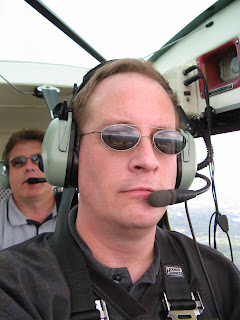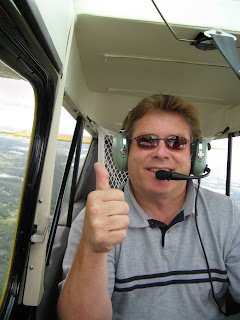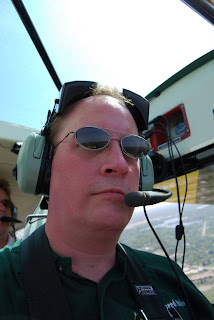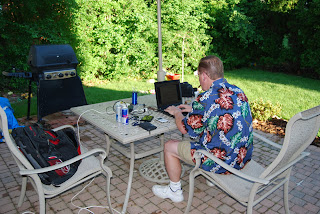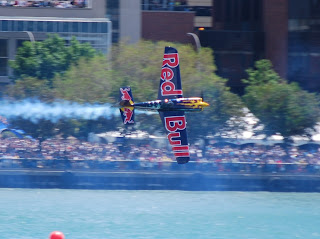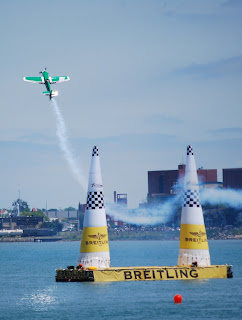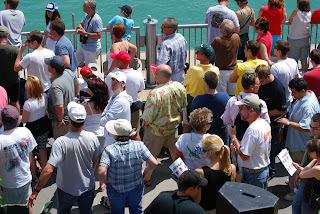This is a regular blog post. Looking for show notes or show audio? Please check out the other entries.
Try this at home! It could save your life. (Just make sure that you do it in a properly certified airplane with a qualified instructor.)
1.3 hours and five three-point landings yesterday in an American Champion 7ECA Citabria. I got a little time in this aircraft with Barry Sutton in May prior to going for the DC-3 type rating – the idea being that I didn’t want to show up in Georgia with zero tailwheel time. What I learned was that the dynamics of the two aircraft are almost completely unrelated. Not that there’s nothing to be learned from one taildragger to the next, but the skillsets are really different. Not unexpected, I guess.
But the experience with the Citabria really made me want to get more time in it. Two objectives here. (1) become proficient enough in the Citabria that Barry says he’d sign me off if I had come to him ab initio for a tailwheel endorsement and (2) cooler still, use this opportunity to explore the flight envelope in terms of aerodynamics, upset recovery, and aerobatics.
So I scheduled some time yesterday to go up with Barry and do just that (er, those).
Weather was cool with good visibility, smooth, and broken ceiling at 3,500 to 4,000. Not so good for serious aerobatics (in my conservative view of things until I gain some more experience), but just fine for basic VFR unusual attitudes.
We started out with demonstrations of stability. Trim the airplane out for straight and level, give the nose a good push, and let her porpoise through four or five oscillations to demonstrate that the aircraft tend toward return to level flight if left alone. Okay, I read about that. I understood it all, too. No problem.
Then Barry pitched us way the hell up. Cranked us over to 50 or 60 degrees of bank and said, “let go.” (Let go?). (Yeah, let go.)
I wish I could say for sure what the airplane did. I think that she yawed gradually around her wingtip with a bit more increase in bank and gradually went nose-down. The cool thing is that the yaw and bank basically damped down and, within about six seconds, we were stable, even if we were looking at a lot of planet out the front window. Throttle back and pull out of the dive and return to straight and level flight.
Guess what? The stability thing works in all three axes. For some reason, they don’t tell you much about that in the primary training literature. But we had the airplane all cranked over and scrambled in all three axes and it returned relatively stable flight all by itself.
Next, we did a spin to the left. The wing dropped off to the left and the autorotation started. Barry pulled the throttle and, after a turn or a turn and a half, Barry said “Let go.” With both of us hands-off, the Airplane broke the stall, stopped rotation within a quarter turn, and became merely a diving airplane instead of a spinning airplane.
I recovered from the dive and took her back to straight and level at 3,000 (about 2,000 AGL). After some more maneuvering, Barry asked me what’s required for a spin to occur. I gave the textbook answer: “The airplane must be stalled and it must be uncoordinated.” But Barry illustrated the truth of yet another precondition. We stalled the airplane and kept it coordinated and the nose came straight back down. Then we stalled it with the ball way outside the middle and let the airplane do what it did. Which is to say that the reaction was very incipient for a long time (more than five or six seconds, which is a long time if you have even moderate reaction time) and, absent keeping the stick all the way back and the rudder floored, so spin ensued.
The take-away is that there’s a practical third element, that being that that condition has to last a long(er)(ish) and/or the stall condition needs to be pretty deep. Modern aircraft don’t really want to stall or spin. If you’re in a stall of the inadvertent VFR kind that doesn’t find you suddenly and extremely cockeyed, you’re probably going to have time to recover. Just don’t do anything stupid, like letting your lizard brain pull back on the controls to accelerate the stall.
There is an extent to which the airplane will take care of itself. Although we were in very unusual attitudes, the aircraft recovered in every instance hands-off with only a power reduction required and then a pull out of the dive (which is easy to do because you’re wings level and have a good look at the ground and/or the horizon and they’re not rotating anymore).
The key is having enough altitude. This stuff takes several hundred feet, if not more than 1,000 feet, to happen. None of this knowledge would be very helpful on the turn from base to final. But I think I’ve seen enough to consider adding “hands off” to my SOP in this type of aircraft if I’m VFR and have altitude to spare. Not sure about other aircraft (e.g. C-172s, etc.), but it sure works in the Citabria.
I’ve said it before, but I’ll say it again. Barry’s a really good instructor. And I know from good instructors. He takes the time to understand what you want out of the flight and presents the material in an ordered, sequential, and helpful way. If you’re looking for tailwheel, high-performance, multi, or similar training, Barry’s your guy. I’m not sure how much primary or instrument instruction he does, but I think that any primary or instrument student would be licky to train with Barry, too.
Obviously, this account is unique to this airplane, this instructor, and this author. Do try this at home because it’ll give you confidence, a better understanding of the flight envelope, and additional tools in your flight bag. It might even save your life. But do it in an aircraft certified for the maneuvers, observe placarded and other limitations, wear a parachute if required, and get a well-qualified instructor who knows you, the aircraft, and the airspace.
Contact information for Barry Sutton:
Sutton Aviation, Inc.
Oakland County International Airport
6230 North Service Drive, Waterford, MI, 48327
248-666-9160
http://www.sutton-aviation.com/
